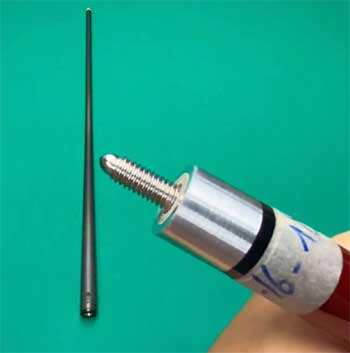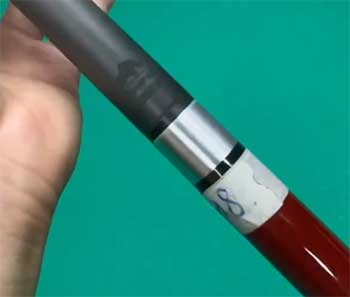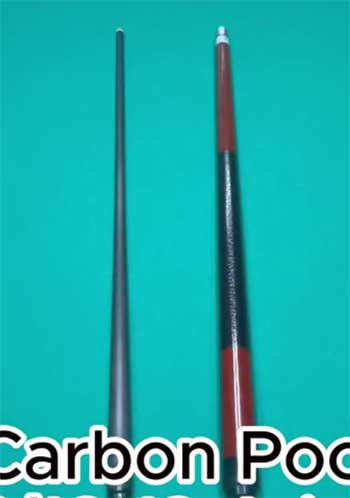If you’re a pool player who craves the consistency and low-deflection performance of carbon fiber but your wallet screams every time you look at the $500 price tags, I want you to stop and listen. You should buy the Rhino carbon fiber shaft. For years, the carbon fiber market has been dominated by a few big names, creating a high barrier to entry. Rhino has kicked that barrier down. It’s not just a “cheaper” shaft; it’s a genuine performer that competes with the giants at a fraction of the cost. I’m here to tell you why this shaft is the real deal.
My Experience With Rhino Carbon Fiber Shaft

I’ve been a “wood guy” for 20 years.
I learned the game on a maple shaft, and I’ve always loved the feel, the feedback, and even the smell of a freshly cleaned wood shaft.
But I couldn’t ignore the carbon fiber wave any longer. My problem? I just couldn’t bring myself to drop half a grand on a Predator Revo or a Cuetec Cynergy without knowing if I’d even like the feel.
That’s when I started hearing the buzz in forums and at my local pool hall about Rhino.
At its price point, I figured it was the perfect, low-risk way to experiment.
When the shaft arrived, I was immediately impressed with the build. It felt solid, the finish was incredibly smooth, and it looked sleek. I ordered the 12.4mm size, and it felt fantastic in my bridge hand. But then I ran into the one, well-known “quirk” of a new Rhino shaft. I’d read the reviews, so I came prepared. I took a microfiber cloth with some 70% isopropyl alcohol and wiped it down. The cloth came away black. Not just a little chalk dust, but a dark, sooty residue. I wiped it again. More black. It took me a solid 10 minutes of dedicated cleaning, using three different parts of my cloth, before the wipes finally came away clean. This is clearly a final step in their manufacturing process that gets skipped, but once it was clean, it was clean. The finish underneath was slick and smooth, with zero tackiness.
I screwed it onto my old Meucci butt, and the joint fit was perfect. The first rack was a revelation. I’m a player who uses a lot of “english” or side-spin, and I’ve spent two decades unconsciously compensating for cue ball deflection—aiming a little bit to the right to make the ball go left. My first few shots with the Rhino, I missed. I missed because the cue ball was going exactly where I was aiming. The shaft is a true low-deflection shaft. It took me about three or four racks to adjust my aim, and when I did, my game changed.
The hit itself is firm and solid. You don’t get that “pingy” or hollow sound that some other carbon shafts are known for. It’s a muted, confident “thud.” The feedback is minimal, which is the biggest change from wood. You don’t “feel” the hit in your hands as much. Instead, you just trust that the shaft is doing its job. After a few months, I can say it has 100% made me a more accurate, more confident player. I can put spin on the cue ball with an authority I never had with my maple shaft because I’m not afraid of the deflection. For the price I paid, it’s not just a good value; it’s the single best upgrade I’ve ever made to my game.
Read more: My Thoughts on OCPTY Auto Parts
Pros Of Rhino Carbon Fiber Shaft
- The Unbeatable Price: This is, without a doubt, the number one reason to buy this shaft. It performs at a level that is 90% as good as the premium shafts, but at 30-50% of the cost. It democratizes high-performance equipment. You no longer have to be a sponsored pro or have deep pockets to get the benefits of carbon fiber technology. It’s the ultimate “bang-for-your-buck” in the billiards world, and it makes the decision to switch from wood an absolute no-brainer. You can buy one of these, try it out, and even if you decide you prefer wood, you aren’t out $500.
- True Low-Deflection Performance: This isn’t just marketing. The shaft genuinely has very low deflection. As I said in my experience, it completely changed my aiming when using side-spin. You can aim with much more confidence, knowing that the cue ball will travel in a straighter line. This allows you to apply spin more aggressively and accurately, which opens up a whole new world of position play. For players looking to move from an intermediate to an advanced level, mastering spin is key, and this shaft is an incredible tool for that.
- Incredibly Smooth Finish: Once you get past that initial cleaning, the shaft’s finish is one of its best features. It is slick, smooth, and almost entirely frictionless. It glides through your bridge hand—whether you use an open or closed bridge—with a consistency that wood can’t match. This is especially true in humid environments or for players whose hands tend to sweat. You can ditch the glove, and you’ll never have to worry about the shaft getting “tacky” or “sticky” mid-match ever again. This smooth-stroke consistency adds a huge layer of reliability to your game.
- Amazing Durability And Warp Resistance: This is a major pro for all carbon fiber shafts, and the Rhino is no exception. It’s tough. You don’t have to worry about it rolling off the table and getting a ding that will snag on your bridge. It’s resistant to scratches and, most importantly, it is practically immune to warping. I’ve left it in my car in both the heat and the cold (something I would never do with my maple shaft), and it still rolls dead straight, every time. This peace of mind is worth a lot. You’re buying a piece of equipment that will last you for years, if not decades.
- Multiple Joint And Tip Options: Rhino isn’t a “one size fits all” product. They offer their shafts in a wide variety of joint pins. Whether you shoot with a Uni-Loc, Radial, 3/8×10, or 5/16×18, they have an option that will fit your cue butt. This is a huge advantage, as it allows you to upgrade your performance without having to buy a whole new cue. They also offer different tip diameters, with the 11.8mm, 12.4mm, and 12.9mm being the most popular, so you can pick the size that best suits your style of play.
Cons Of Rhino Carbon Fiber Shaft

- The Infamous Residue Issue
- It Requires Immediate, Thorough Cleaning: I cannot stress this enough. When you unbox this shaft, it is not ready to play. It is covered in a fine, black, carbon-dust-like residue from the manufacturing process. You must clean it, and clean it well.
- How To Fix It: Grab a clean microfiber towel and 70% (or higher) isopropyl alcohol. Do not use any other solvent. Dampen the cloth and wipe the shaft down firmly. You will see a lot of black gunk come off. Keep wiping with clean sections of the cloth until it comes away completely clean. This might take 10-15 minutes. It’s annoying, and it’s a corner Rhino is clearly cutting to keep the price down, but it’s a one-time fix.
- The Stock Tip Is A Letdown
- Very Hard And Inconsistent: To meet this price point, sacrifices have to be made, and the stock tip is one of them. The tip that comes on the shaft (often an F1 Crystal Tip) is typically very hard. I found it difficult to scuff, it didn’t hold chalk well, and it led to more miscues than I was comfortable with.
- Plan On A Replacement: I strongly recommend that you factor the cost of a tip replacement into your purchase. I played with the stock tip for a week and then had my local cue smith install my favorite Kamui medium tip. The difference was night and day. Once I had a quality, layered tip on it, the shaft truly came alive. So, when you buy this, just assume you’ll be spending an extra $30-$50 for a new tip and installation.
- The “Feel” Can Be Muted
- Minimal Feedback: This is a common critique of many carbon fiber shafts, but it feels particularly true for the Rhino. The shaft is designed to absorb vibration and transfer energy efficiently, which results in a very “dead” or “numb” feel on impact. You don’t get the same rich, tactile feedback that you get from a wood shaft.
- An Adjustment Period: For me, this was the biggest hurdle. I had to learn to trust the shaft’s performance with my eyes rather than the feel in my grip hand. It’s a different way of playing, and it takes some getting used to. If you are a player who relies heavily on the “feel” and sound of a shot, this will be a significant adjustment.
Maintenance Tips For Rhino Carbon Fiber Shaft
- The Most Important First Step
- The Initial Deep Clean: I’m putting this here again because it’s both a “con” and the most critical maintenance tip. As soon as you get it, dedicate 15 minutes to cleaning it with 70% isopropyl alcohol and a clean microfiber cloth. Do this before you ever chalk it or hit a ball. Wipe it until the cloth is perfectly clean. This one-time process is the foundation for a great experience.
- Routine Daily/Weekly Cleaning
- Dry Wipes Are Your Best Friend: Carbon fiber is incredibly low-maintenance. After every session, just wipe the shaft down with a clean, dry microfiber cloth. This will remove any chalk dust, hand oils, and grime. This is all you need to do 99% of the time to keep that finish feeling slick and smooth.
- Avoid Abrasives: Whatever you do, never use sandpaper, Scotch-Brite pads, steel wool, or any abrasive on this shaft. You are not “cleaning” it; you are permanently scratching and destroying the smooth finish. If you have a stubborn spot, a specialized cue-cleaning wipe is the way to go.
- Specialized Wipes For Deep Cleaning: If your shaft ever starts to feel a bit tacky from oil buildup, use a wipe made specifically for carbon fiber shafts. Brands like Cuetec and Predator make excellent shaft cleaning wipes. A quick wipe-down with one of these will restore that “like-new” glide.
- Long-Term Care And Protection
- Avoid Waxes And Conditioners: Do not treat your carbon fiber shaft like a wood one. It does not need to be waxed, sealed, or conditioned. These products will not soak in; they will just build up on the surface, creating a sticky, gummy mess that ruins the feel of the shaft.
- Protect The Tip And Ferrule: While the shaft is super durable, the tip and ferrule area are still vulnerable. Avoid tapping the tip on the table or hard surfaces. When you aren’t playing, use a good set of joint protectors to keep the pin and joint face clean and safe from dings, which can affect how the shaft screws on.
- Storage Is Still Important: While it won’t warp like wood, it’s still good practice to store your cue in a quality case. This protects it from major impacts, scratches, and keeps it clean. A good case is a cheap insurance policy for your entire cue.
Read more: My Thoughts on CCIYU Auto Parts
Comparison With Other Brands

- Against Predator Revo: The Revo is the 800-pound gorilla in the room. It’s the “gold standard” and has the price tag to match. In my testing, the Revo has slightly less deflection than the Rhino, but we are talking about marginal, almost imperceptible differences for the average player. The biggest difference is the feel. The Revo feels even more “dead” or hollow to me, with a distinct “ping” on impact. The Rhino has a more solid, fuller “thud.” The Revo is an amazing piece of engineering, but for my money, the Rhino provides 95% of the performance for less than 50% of the price.
- Against Cuetec Cynergy: This is a much closer comparison in terms of feel. The Cynergy, which is famously used by pro Shane Van Boening, has a polyurethane foam core, which gives it a more solid feel that’s a bit closer to wood. I find the Rhino and the Cynergy to feel very similar on impact. The Cynergy is a fantastic shaft, but again, it is significantly more expensive than the Rhino. Many players in blind tests have trouble telling the two apart. The Cynergy’s fit and finish might be slightly more polished out of the box (i.e., no residue to clean), but the on-table performance is remarkably close.
- Against Meucci Carbon Pro: The Meucci Carbon Pro is designed to do something different. It’s a carbon fiber shaft that tries to feel like a maple shaft. It has more flex and feedback than the Rhino, Revo, or Cynergy. It’s an excellent choice for a long-time Meucci player who wants to keep that signature “soft” Meucci hit but get the consistency of carbon fiber. The Rhino is much stiffer and has far less feedback. This isn’t a “better or worse” comparison; it’s adifference in philosophy. If you want that classic wood feel, the Meucci is a great hybrid. If you want the pure, stiff, low-deflection performance of modern carbon fiber, the Rhino is the clear choice.
Frequently Asked Questions (FAQ)
Yes, absolutely. They are true low-deflection shafts. Their performance in this area is their biggest selling point and is comparable to much more expensive brands. You will have to adjust your aim when using side-spin because the cue ball will not squirt off-line as it does with a traditional maple shaft.
“Best” is subjective and depends on your budget and feel preference. The Predator Revo is often considered the most technologically advanced with the lowest deflection. The Cuetec Cynergy is a close second and preferred by many pros for its solid feel. However, for the vast majority of players, the Rhino shaft is arguably the “best value,” offering top-tier performance for a budget-friendly price.
For any serious player, I believe it is 100% worth it. The benefits are undeniable: massive reduction in cue ball deflection, incredible consistency, an always-smooth stroke, and near-invulnerability to warping and dings. It’s a one-time upgrade that will tangibly improve your accuracy and confidence and will last for decades.
You will see a wide variety of cues used by professionals, as many are sponsored. However, the two most dominant brands on the pro tour right now are Predator and Cuetec. You will see a sea of Predator Revos and Cuetec Cynergies at any major tournament, along with high-end custom cues from makers like Joss and Meucci.
Conclusion
After months of playing with the Rhino carbon fiber shaft, I can tell you it’s not a gimmick. It’s a serious piece of equipment that has permanently changed my game for the better. Yes, you have to do a 10-minute deep clean out of the box, and you should absolutely replace the stock tip. But even after factoring in the cost of a new tip, you are getting a high-performance, low-deflection, warp-proof shaft for a price that is simply unmatched. If you are on the fence about switching to carbon fiber, I’m telling you to do it. You should buy this product.
